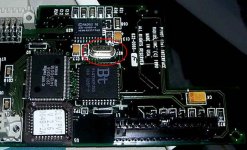Maybe I'm a bit late, but...
Don't give up! Unless your card is able to make an actual
composite NTSC signal (instead of the common
RGB output with NTSC
timing on many Macs) that 14.318 MHz crystal won't be used as the NTSC Chrominance encoding reference...
More good news: the
official dot clock for 16" mode (832x624 @ 75 Hz) is
57.2832 MHz -- divide that by 4, and you get about
14.32 MHz, which is
very very close to your crystal. That slight underclocking (less than 0.02%) won't affect any monitor at all, and allows the use of a very common (read:
cheap) crystal. Besides its use in colour TVs, 14.318 MHz divided by three makes...
4.77 MHz. Does that sound familiar?

So, we can assume that crystal is the timebase for 16" at 75 Hz refresh... in order to underclock for 60 Hz refresh, you want a crystal
0.8 times (60/75) the frequency -- something like
11.45 MHz, a bit higher or lower won't harm, just check what's available.
PLEASE NOTE:
I haven't actually tried this, so act at your own risk. Anyway, in case it won't work as intended, I think it's very unlikely that it would damage anything.




